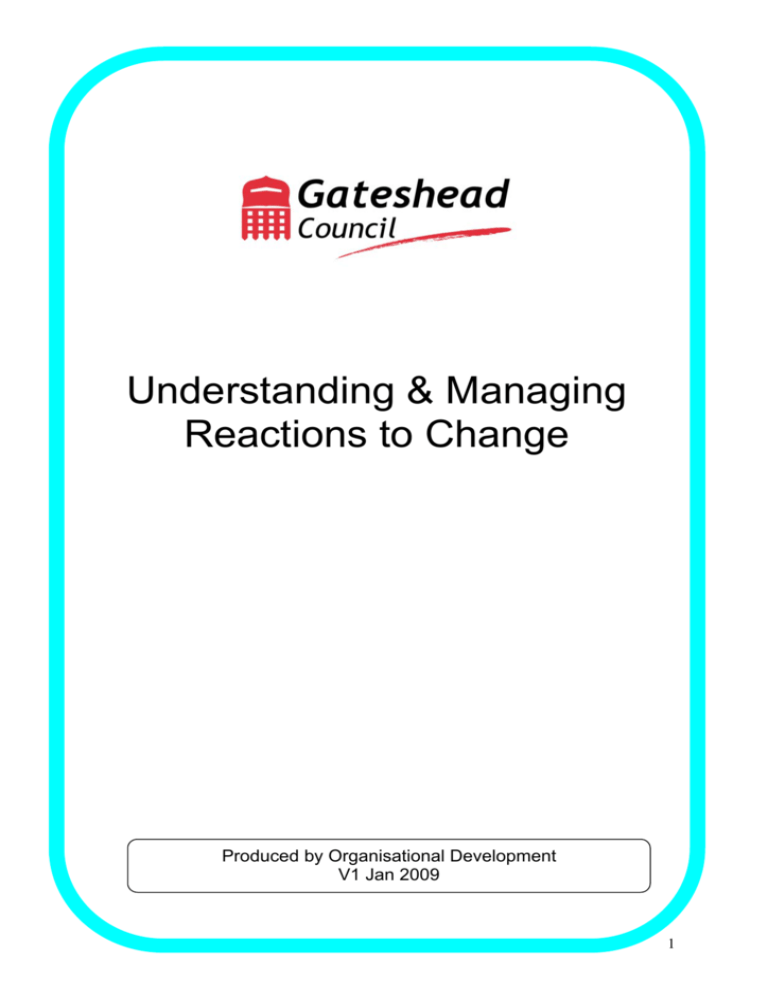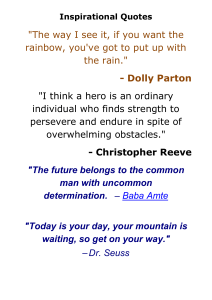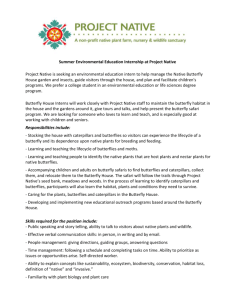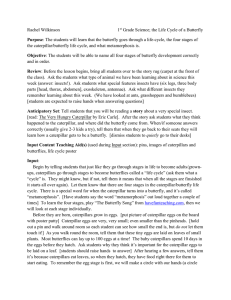Understanding & Managing Reactions to Change
advertisement

Understanding & Managing Reactions to Change Produced by Organisational Development V1 Jan 2009 1 Contents Page Page No Reactions to Change………………………………………………..3 Understanding and Managing Resistance………………………...4 Terrorists and Champions……………………………………….….4 How Do People Deal with Change? ……………..………………..6 Why Do People Resist Change? ………………………………….8 Stack the Odds in Your Favour……………………………………10 Understanding the Iceberg………………………………………..13 Roles and Resistance……………………………………………..15 Commitment Planning……………………………………………..16 Managing Resistance……………………………………………..17 Political Integrity……………………………………………………19 Caterpillar and the Butterfly…………………………………….…20 Storytelling……………………………………………………….. 22 2 Reactions to Change Series Reactions to Change Change today is more complex, often more transformational and the pace of change is ever increasing. This means we need to spend more time making sense of it all, learning about things that go well and not so well –and more time as managers helping people cope When change hits us, it disrupts the status quo and can really de-stabilise people, especially if it means giving up things they hold dear Balancing Stability and Change When change hits us it disrupts the status quo Which results in feelings of disequilibrium (feeling off balance) and dischord Responding to Change Anxiety and disorientation is a normal response, and people need time to deal with what is happening. There are four main stages people go through shock adaption acceptance 1 2 3 4 defensive retreat 3 The length of time it takes to move between the stages depends on: • • • • • • • The state of the individual The scale of the change The way change has been managed before How much change they have had to cope with recently The way this change is being managed Their level of involvement Support they get from others If major change is needed its particularly important to contain (neither reject, nor reinforce feelings and reactions). Anger, denial, anxiety, sadness and depression are all common. As they are expressed and the realities of the situation are gradually absorbed more considered responses and alternative proposals will emerge - that’s when it is time to offer more detailed plans Managers have a key role to play in helping people move through the stages Understanding and Managing Resistance Terrorists and Champions “ Terrorists” and “ Blockers” “Champions” 50% 5% Will never change 20% 20% Will when there is no other option Actively resist change Wait to see what happens Go with the flow 5% Get included Lead the at the first change opportunity Actively welcome change 4 This diagram is saying people react to change in different ways: • • • • • Some (the enthusiasts), see it as an opportunity.- get a buzz from the challenge and a new sense of direction, and champion change. Some are a bit more cautious- they sit back and wait to see what happens Others see it as a threat, may withdraw or resist until there is no other option. There are the cynics- the “yes butters”...”yes but that will never work”...”we tried that before” Others (the terrorists) might block or even sabotage. There are usually a small number who have learned to live through change programmes without really changing at all It’s saying: • • • • • 5% of people will lead the change 20% get involved at the first opportunity 50% wait and see what happens 20% will when there is no other option 5% will never change Identify your early adopters, the people who are passionate, will lead and drive change-use them to bring the rest on board. If you can win round some one who is known to be cynical/not on board to the point where they champion change that can have a powerful impact on others. Go round the 5% that will never change like water over a stone- or give them an exit strategy! (Bear in mind the reality is there are those who start off as enthusiasts who are suffering from initiative overload and become jaded having had to cope with one initiative after another – find ways to give them some stability however small) 5 Reactions to Change Series How People Deal with Change Jungian theory (the one behind the MBTI personality type questionnaire you completed in the first module) offers the following model on the way people react to change. Task Orientated People Orientated Analyticals Drivers Amiables Expressives Reactive Proactive Drivers are proactive, task-orientated types who are always willing to lead. They love change and will throw themselves into new and untested areas because they live in the present moment. What they lack in reflective skills they make up for in energy. Pushed to the brink they become tyrants. Expressives are proactive, people orientated types who have a lot of imagination, intuition and creativity. They are good at looking at the world in fresh ways and look forward for their inspiration rather than back. Their lack of task orientation however, means that they are more likely to talk a good change story than to deliver a good change. At the extreme, they can become so enamoured of change that they can’t function in a stable environment. Amiables are reactive, people orientated types, the kind everyone loves to have around. They are nature’s diplomats. They resist change because they don't like what it does to people. They are experts in maintaining relationships but their orientation is stability and ensuring other people’s needs are met. When pushed, they cave in. Analyticals are the reactive, task orientated types, perfectionists who want to bar entry to the unknown until it is proven safe. Their change mode is denial. They are victims of their own clarity of thinking. Their facts must be the right facts and the need for certainty causes havoc with the need for 6 experimentation during change programmes. They look backwards for inspiration. At their worst, analyticals lose themselves in the task and lose perspective in the process. These four types are at the extremes and most of us can be plotted towards some other point on the graph but it can be a useful pointer to help you work out how people on your team might cope with change. 7 Reactions to Change Series Why Do People Resist Change? People resist change for all sorts of reasons: The vision isn’t clear No one has outlined what change will mean for them in practice Communication is poor Low levels of involvement and engagement They don’t stand to gain or they stand to loose something Experience of badly managed changed Initiative overload It’s too complex They have no focus of control and feel done to Self interest They are in their comfort zone Threat to skill or competence Threat to power base, status, or autonomy It will lead to unintended consequences elsewhere It’s too sudden Reluctant to experiment They are in change shock They actually think there is a better way Other Reasons Why Change Fail It was the wrong idea in the first place - e.g. changes that address symptoms not causes often fall into this category. It was a good idea at the wrong time - e.g. going straight from no appraisal system to a 360- degree appraisal system. You’re doing it for the wrong reason - e.g. flatter hierarchies to get rid of staff not to improve decision -making. It lacks authenticity and sincerity - e.g. you’re doing it because you’ve benchmarked and found that everyone else is doing it rather than because you really believe it’s right for your organisation. It is internally inconsistent - e.g. going for harmonisation but keeping the executive dining room. You lose perspective - e.g. getting so bogged down in producing a quality management system that you lose sight of the reason why you wanted to introduce a QMS in the first place. 8 Leadership too closely associated with the status quo - e.g. a MD with a background in finance and a reputation for concern with keeping costs down suddenly becomes a convert to TQM and throws money at the programme as an act of faith and wonders why nobody believes him. People are not prepared for, or convinced of, the need to change - you didn’t bring people in on the change at the earliest opportunity. You get carried away - e.g. introducing a teamworking initiative even in places where teamworking is counter-productive. You don't get carried away enough - e.g. using the TQM language and paying lipservice to the principles but not changing the way you think or behave. Bad luck - something unforeseen happens which overtakes the change and makes it redundant. 9 Reactions to Change Series Stacking the Odds in Your Favour Suppose the change equation looks something like this: C = A x B x D > X where: C A B D X = = = = = the probability of change being successful; dissatisfaction with the status quo; a clear statement of the desired future state; concrete first steps towards achieving the desired future state; the cost (not just financial) of the change. One way of stacking the odds in your favour is to adopt a strategy which changes the weight of A (dissatisfaction with the status quo), B (clear statement of the desired future state) or D (concrete first steps towards achieving the desired future state) variables so that the balance of the equation shifts in favour of the benefits of the change outweighing the costs. Raising levels of dissatisfaction with the current state can be tough especially with people who have worked in one organisation for most of their career, who do not have anything to use as a comparator, who may not be able to imagine things working differently or better and who may not therefore feel a sufficient level of dissatisfaction with the current state to make them feel the need for change. Being consistent about what the desired future state, especially if you draw people into the process of painting in the details, and going for some ‘early wins’ is a lot easier. Managing the Key Moments Six key moments in the change process ‘Why Change Doesn’t Work’, Robbins and Finley: Catalysing - this happens when the change maker first brings the change idea into creation. Encoding - this happens when the changemaker communicates the need for change and the idea to close followers so they understand it. Imagining - this happens when the close followers can see what the change maker sees and are willing to be part of making it happen. Uniting - this happens when momentum is building and more and more people are sharing the same vision so that people with dissenting views begin to feel pressured to join in or move on. 10 Fitting - this happens when people start to identify aspects of the organisation that don't fit with the change and begin rooting them out and making them compatible. Gelling - this happens when the change is no longer seem as a change because it has become organisational reality. As each stage of the change process blends into the next one, the trick here is to spot the key moment in sufficient time to be able to capitalise on it. It does however, imply a building process of: using communication to reinforce the messages of the change, picking the key players and winning them over first then spreading the message out until it is picked up by a critical mass of people - all of which is pretty basic change management practice. The People Issues Common sense says that the most effective way of successfully making change happen is to take people with you by creating commitment to and ownership of the change. Many of the reasons why change fails are to do with mismanagement of the people issues. Managing Resistance to Change Some academics argue too much fuss is made about the importance of managing resistance to change “it is often possible to encourage ‘resistance to change’ by dealing with people as if that is the only response one expects!” (Colin Carnall) An Alternative Theory Obviously, it is sensible to have a clear understanding of the psychology of resistance to change if only so that you are prepared for the worstcase scenario! Having said that, probably only reactionary Theory X managersbelieve that managing change is synonymous with managing resistance. Actually: People are not inherently anti-change and most will embrace change provided it has positive meaning, (or, more crudely put, which addresses the ‘wiifm’ factor. People do what they perceive is in their best interests thinking as rationally as circumstances allow them to think. People are different and no single approach to managing change will address the entire breadth of these differences. Actions speak louder than words so people who practice what they preach and are an example of post-change behaviour are more likely to be supported. 11 This opens up a whole new set of possibilities for managing change: Involving people so that change has meaning for them; Giving them the quantity and quality of information they need to make rational decisions about what is in their best interests; Matching the method of communication and involvement to the needs of the different impact and interest groups; Making sure that the way you act during the transition stage is compatible with the desired future state. A classic example of how not to do it comes from an organisation who embarked on a TQM programme and developed a set of cultural values which talked about involving employees and respecting their contribution but who didn’t see fit to involve the employees in developing the set of values in the first place! Activity What strategies have you used that have worked? 12 Reactions to Change Series Understanding the Iceberg Impact of Change On An Individuals Identity Every change is a change in meaning. Understanding the impact of change on people’s identity is crucial. People will only own what makes sense to them and fits with their sense of self. Shared meaning is critical- this cannot be achieved by superficial tell and sell. To really engage someone you need to know what matters to each individual, what’s going on under the surface - especially if you need to find ways of encouraging them to focus on possibilities rather than what the change is likely to costs them. W ho I am a n d th e C h o ice s I M a k e D e te rm in e s h o w I Behave B e h a vio u r C o m p e te n c y Our o u te r s e lf C h o ic e s w e m a k e V a lu e s & B e lie fs S e n s e o f S e lf (Id e n tity ) Our deep s e lf Q u a lity & E q u a lity L td 13 Group Dynamics At an organisation or group level change efforts often focus on what’s above the waterline (the “hard” side of change). This can be one of the main reasons why change efforts fail. Group Dynamics deals with what’s below the waterline /O e tiv c e bj r St r tu c u es Content e s s es os le ol p ul c b r R to ra / es Pu ro s gi ve i P e l t rm ra De No St s ic s elief nam B y & D er es Pow Valu s e orms ed n Cliqu ion s s e ic s pr ect Unex ynam / Rej D e y c t i n pta onal i on Acce Pers cept s r a i e p B t M is trus ion / / Mi s t s t p n s e o u i Tr Perc ctat da expe agen n e n k e nce o d Hid m nfide Unsp e o e C t Es Self Self Process Activity Reflect on a previous change you have experienced or managed? What went well and why? What didn’t go so well and why? Was Commitment Planning effective? Was resistance anticipated and managed? 14 Reactions to Change Series The Relationship Between Role and Resistance Kanter et al (1992) One school of thought is that there are three different roles in any change process: • Strategists and initiators - who initiate and set the direction • Change implementers - who coordinate and implement the change • Change recipients - who are strongly affected by the change and its implementation (These roles are not mutually exclusive- strategists can get involved in change and vice versa). Our attitude to change is influenced by the role we play (equally having to play a different role can sometimes change our change our attitude) Change recipients have much less control over the change and this can be a common source of conflict and resistance. If you feel like a pawn in someone else’s game without the opportunity to put forward ideas and get involved you will be unlikely to share their sense of excitement. If you feel you can influence what’s happening you will be more likely to commit in practice. Involving as many people as possible in shaping the future generates more ideas, helps people cope, and accelerates the pace of change- it also helps minimise resistance Our attitudes to change are also influenced by what we stand to gain or lose personally (will it affect our work, salary, lifestyle etc) using a table like the one below can help you anticipate reactions and think through your influencing strategies Team Member A Role Stands to Gain Strategist B Implementer C Implementer D Recipient Stands to Loose Usual Reactions Action / Support Required Experience Status Drives Change Give Space Promotion Will drive change but needs to understand power & politics Sabotage Coach Status Cuedos Keep them close, Be clear about what’s expected. Give them time to air concerns. Keep communication channels open 15 Reactions to Change Series Commitment Planning Commitment Planning is a similar, useful technique. This involves listing key individuals or groups down one side, levels of commitment headings across the top: • • • • Opposed or not committed Let - will not actively oppose change but equally will not actively support it Helper - will support the change with time and resources, providing someone else leads Driver - will lead/ make it happen Each individual or group is rated with a zero to indicate their current position and an x is then plotted to indicate the degree of committed required if the change is to be achieved- the difference between the two is a crude measure of the work that needs to be done Individual or Group A Opposed B 0 Helper Driver 0 x C D Let x x 0 x NB: Sometimes it may be appropriate to reduce the level of commitment, move the leadership to other people and sometimes no more work is required to secure commitment 16 Reactions to Change Series Strategies for Minimising Resistance Above all else involve people “People will help support what they co-create” Marvin Weisbord 1) Paint a compelling vision of the future, 2) Paint pictures for people of what change means for them in practice Involve them in looking at where are we now, where do we want to be, how can we get there? What will be the same/ different, what people will be doing 3) Create a burning platform for change 4) Help people make the paradigm shifts required Paradigms / Mind Maps The way we see things The way the job should be done What’s right and wrong How the service should be delivered Sometimes roles change, services need to be delivered fundamentally differently. This means that people need to think and act differently. To get the shift in thinking we need to create some dissatisfaction with the status quo - explain why old ways of working are no longer effective (stories and anecdotes can be very useful here). 17 Being really explicit here about what we are changing from and to is really important, e.g: • • • • Reactive to proactive and responsive Workload /project driven to customer driven Problem oriented to solution focussed Professional we know best to, enabling supporting Other strategies for minimising resistance 5) Bring in experts who have delivered something similar well 6) Communicate like never before too scotch rumour- if nothing is happening tell people that. Remember there is no hierarchy to information- people need to know what they need to know to deliver the change 7) Get people involved, get their ideas and give them a role in to play 8) Create an empowered culture, where everyone can initiate and explore Change -and make the parameters clear 9) Most people want to connect with others- build coalitions and networks 10) Make time to hear concerns, reduce anxiety 11) If possible allow people to hang onto their identity 12) Negotiate effectively- know what your bottom line is- be prepared to give something up 13) Allow people time to move through the change curve 14) Give them the skills they need to succeed 15) Live by the values and give them support 16) Use peer group pressure, and change champions to get people on board 17) Pay real attention to managing the transition 18) Celebrate quick wins 19) Mark the ending say goodbye to old ways of doing things Above all else - be the change you want to see 18 Reactions to Change Series Managing Change Politially (Baddeley & James) Politically Aware Inept Innocent Self -Centred Wise Acting with Integrity Clever Politically Unaware The challenge for managers is to balance political awareness with their own integrity. Wise managers read how their organisation works, who has what agendas, where the power lies and what the culture is. Managers can be measured on two scales: The Vertical scale is political awareness The Horizontal scale is integrity. At the left hand side of the scale are managers who are interested solely in their own achievement. At the right hand side of the scale are managers who function with integrity. Inept = Politically Ignorant Lacking integrity Clever = Politically Astute Self Serving Innocent = Politically Ignorant Full Integrity Wise = Politically Astute Full of Integrity Self serving don’t know how to align to own agendas 19 Reactions to Change Series The Caterpillar and the Butterfly Change is about taking everyone with you –those who are comfortable plodding along and set in their ways as well as “the I‘m up for its” The story of the caterpillar and the butterfly is often told to initiate a discussion around this “Two caterpillars are conversing and a beautiful butterfly floats by. One caterpillar turns to another and says “You’ll never get me up in one of those butterfly things” This story is not about resistance and doesn’t have a single answer. Many people have been consulted over the years- these are their responses • • • • • • • • • • Sometimes we expect microwave results- from a slow cooker. Sustainable change is never fast. It relies on exploring new ideas ,new possibilities, listening, capturing potential- and robust option appraisal. Caterpillars have no need to fly they are well grounded So that sometimes means they don’t even fly Caterpillars can eat anything green and find food anywhere. They can crawl and climb But they focus on eating and survival Butterflies have to fly to get anywhere= that means they get blown around in the wind Its easier for them to develop perspective than caterpillars because they can fly You have to stop being a caterpillar to become a butterfly We can choose which one we want to be- change occurs anyway- choose your stance Metamorphosis isn’t a dark d scary place people get scared its less crazy if you know you are going to be a butterfly How Does this Relate to Change? • Change is inevitable- chose your stance • Caterpillar or butterfly? • Some people are on a Ferrari to the vision, others are on bike, others are walking- different strokes for different folks 20 Lepidoptera (moths and butterflies) • • • • • • There are 140,000 species of moths- but only 16000 species of butterflies Moths have feathery antenna-butterflies have a bulb on a stalk Most moths have tremendously sensitive antenna that transmit sexual attraction phenomena in parts per billion. For Luna Moths the sole purpose of their lives is reproduction They feed on milkweed which serves to protect them- birds find their taste aversive so don’t eat them Certain caterpillars like the Crystalline Limacodid have bristles that dispense toxic chemicals. Getting too close to them is a painful experience Some caterpillars eat as much as 27 x their body weight Can We Change? “ In the change from becoming a caterpillar to a butterfly you are nothing more than a yellow gooey sticky mess” “Change involves discomfort and requires commitment” 21 Reactions to Change Series The Power of Stories Telling stories can be very powerful when persuading people of the need for change, communicating vision and purpose. They engage our hearts and minds, hit people in the gut as well appealing to their heads. Remember Martin Luther King “I had a dream” Leadership Stories • Who you are • Stand for something and say what you stand for • Why you are here • Your hopes and dreams • Your values in action • Make point memorably Change Stories • Honour something from the past • Acknowledge people-heroes and heroins • Imagine possible futures-what if?......... • Introduce radical new ideas • Anticipate change and transition • Stories that illustrate behaviour that is not appropriate • Consequences of doing nothing They can also be useful for building effective teams and managing conflict- by fictionalising real characters we can laugh at our behaviours. Stories people tell can give you a powerful insight into the way people see the world and their situation A Good Story • Has a beginning, middle and end • Is timely and told with conviction and feeling • Uses clear language and images • Is enlivened by rich sensory detail • It can be funny sad ironic • Is just long enough- no longer • Is authentic-personal to the teller • Be vulnerable • Avoids lecturing and obvious moralising 22 Bear in mind its a three act play: Act One- Setting the Scene When where who, characters Motivation- what is wanted or needed Act Two – The Drama The struggle between expectations and realtiy Overcoming obstacles Act Three- Pay Off What has changed as a result? What have we learnt? Activity - Practice Storytelling Story change themes on cards- performance and accountability; teamwork and collaboration; customer focus, sustained commitment to change 1) Take it in turns to tell a two minute story to your partners in response to the trigger on the card 2) Get someone to tell you when your two minutes are up 3) Let the person tell their story and listen- if they get stuck ask for more detail Discuss what behaviours were noteworthy- what do those behaviours suggest about the values being enacted. How could you communicate the values without them appearing bland and meaningless? 23







